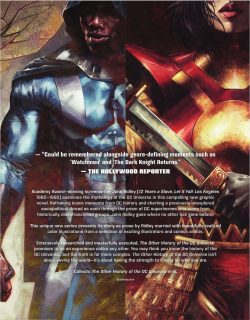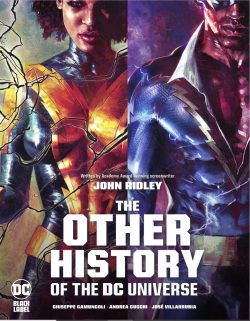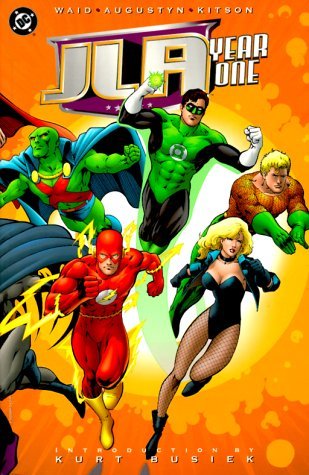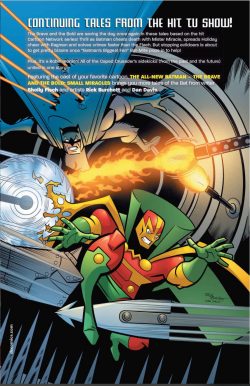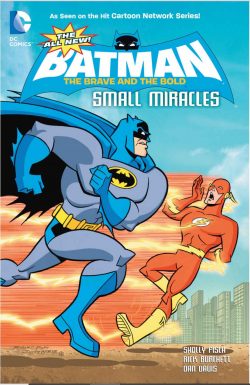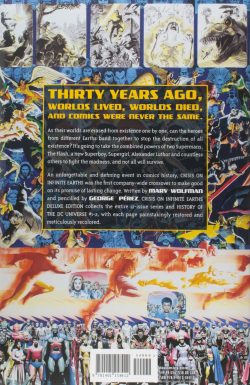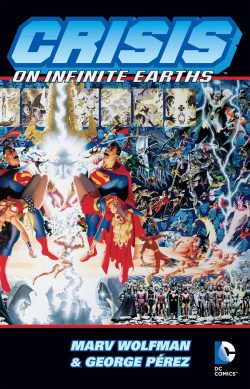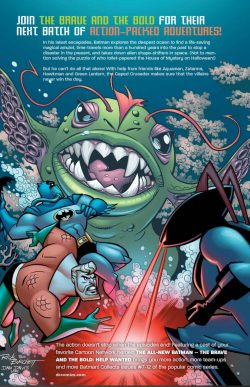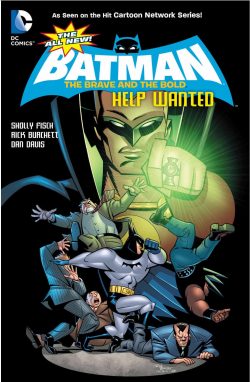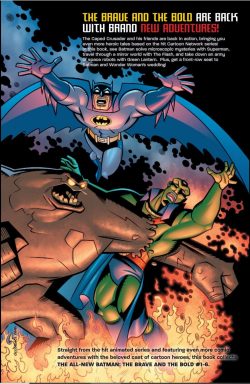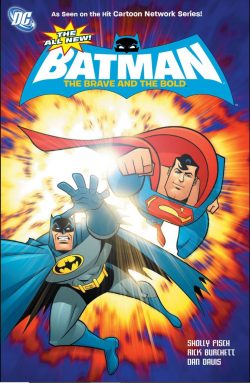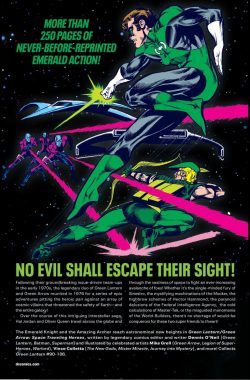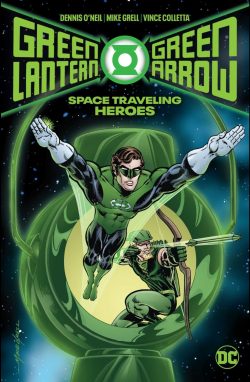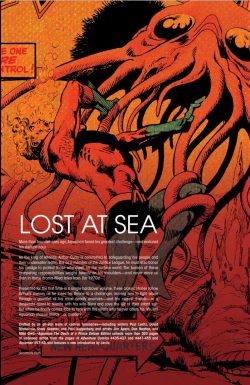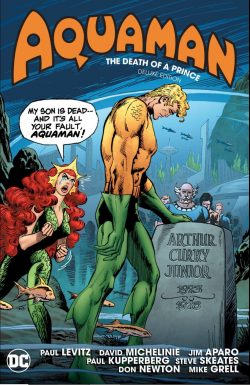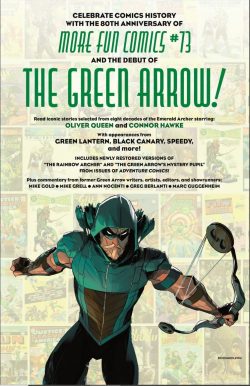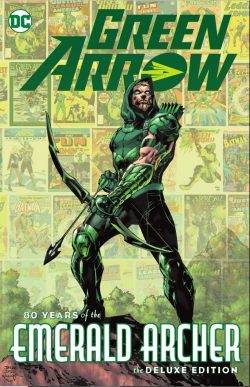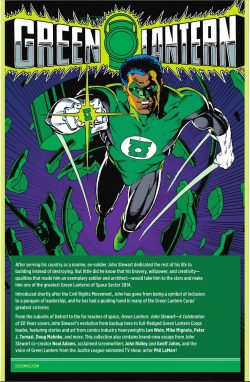
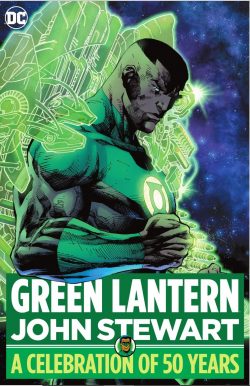
By Neal Adams, Dennis O’Neil, Len Wein, Steve Englehart, Christopher Priest, Jim Starlin, Ron Marz, Judd Winick, Geoff Johns, Tony Bedard, Peter J. Tomasi, Van Jensen, Robert Venditti, Stuart Moore, Derek Fridolfs & Dustin Nguyen, Dave Gibbons, Joe Staton, Gil Kane, Mike Mignola, Darryl Banks, Dale Eaglesham, Ed Benes & Maros Marz, Tyler Kirkham, Fernando Pasarin, Igor Lima, Rodney Buchemi & Geraldo Borges, Pat Broderick, Doug Mahnke, John Delaney, Eric Nguyen & various (DC Comics)
ISBN: 978-1-7795-1125-6 (HB/Digital edition)
Win’s Christmas Gift Recommendation: Making Wishes Come True… 8/10
Now a cornerstone underpinning the entire DC Universe, the many heroes called Green Lantern have waxed and waned over eight decades and are now much more Concept than Character. This stunning compilation – part of a dedicated series introducing and exploiting the comics pedigree of veteran DC icons – offers a brief but astoundingly enticing sequence of snapshots detailing how one particular Emerald Gladiator broke many boundaries whilst battling evil and injustice for the entertainment of millions across many generations.
This book features material from Action Comics #601, Batman Beyond Unlimited #4-5, Cosmic Odyssey #2, Green Lantern (volume 2) #87, 182, 185, Green Lantern (volume 3) #74, 156, Green Lantern (volume 4) #49, Green Lantern Corps #211, Green Lantern Corps (volume 2) #60, Green Lantern Corps (volume 3) #9, Green Lantern: Futures End, #1, Justice League #1 (volume 4) #6, 40, Justice League Adventures #22, Justice League of America #110 and Secret Origins (volume 4) #9. These tales span cover-dates January 1971 to April 2020), with the groundbreaking appearances are preceded by brief critical analysis of the significant stages in his development, beginning with Part I: 1971-1985 – A Sign of the Times and a revelatory essay by legendary activist and comics iconoclast Neal Adams who shares the secret origin of the first Green Lantern of colour before we enjoy that seminal classic…
Originally created by Martin Nodell & Bill Finger, the first Emerald Avenger – Alan Scott – debuted in All-American Comics #16 (July 1940), just as superheroes started to take hold, and supplanting newspaper strip reprints and stock genre characters in still primarily-anthologised comic books. He was a white guy with a magic ring and an icon of his era.
After superheroes vanished and returned in the early 1950s, another GL was created: once again a symbol of his era. After the hugely successful revival and reworking of The Flash, DC/National Periodicals were keen to build on the resurgent superhero trend. Showcase #22 hit the stands at the same time as the fourth issue of the new Flash comic book (#108) and once again the guiding lights were editor Julie Schwartz and writer John Broome. Assigned as illustrator was action ace Gil Kane, inked by Joe Giella.
A vivid Space Age origin revealed how young test pilot Hal Jordan was plucked from his Californian aircraft factory by an alien policeman who had crashed his spaceship on Earth. Mortally wounded, Abin Sur commanded his power ring – a device to materialise thoughts – to seek out a replacement officer who was honest and without fear. Scanning the planet, it selected Jordan and brought him to the crash-site. The dying alien bequeathed his ring, lantern-shaped Battery of Power and his professional vocation to the astonished Earthman.
In six pages ‘S.O.S Green Lantern’ established characters, scenario and narrative thrust of a series that became the spine of DC continuity, leaving room for another two adventures in that premiere issue. Unlike the debut of The Flash, the editors were now confident of their ground. Two more Showcase issues carried even greater exploits, and six months later Green Lantern #1 was released.
For the new iteration, emerald ring-wielders were a members of a universal police force and Jordan’s “beat” – which included planet Earth – was Space Sector 2814. Having introduced the cosmic peacekeepers, Broome, Gardner Fox and others expanded the concept throughout the 1960s, adding alien and even female GLs, and alternate human Lanterns like Charlie Vicker and Guy Gardner. They even brought back the original as Alan Scott (now designated Green Lantern of alternate world Earth-Two) became a semi regular cast member…
Over many traumatic years, Jordan grew into one of the greatest members of a serried band of law-enforcers. For billions of years, the Green Lantern Corps protected and served the cosmos, policing countless numbers of sentient beings under the severe but benevolent auspices of immortal super-beings who deemed themselves Guardians of the Universe.
These undying patrons of Order were one of the first races to evolve and dwelt in sublime, emotionless security and tranquillity at the very centre of creation on the small world of Oa.
Primarily chosen for their capacity to overcome fear, Green Lanterns are equipped with a ring that creates solid constructs from emerald light. The miracle weapon is fuelled by the strength of the user’s willpower, making it one of the mightiest tools imaginable.
For eons, a single individual from each of the 3600 sectors of known space was selected to patrol his, her, their or its own beat. Being cautious and meticulous masters, the Guardians laid contingency plans and frequently appointed designated reserve officers to inherit the office of their peacekeeping representatives.
Jordan’s usual substitute was quiet, steadfast PE teacher Gardner, but when the other white Guy was critically injured and required long-term recuperation, the Guardians’ fallback option was somewhat worrying to staid, by-the-book Hal. In #87 (cover-dated December 1971/January 1972 and crafted by Adams, his scripter of choice Denny O’Neil & inker Dick Giordano), ‘Beware My Power!’ introduced a bold new character to the DCU, conceived at a time when non-Caucasian heroes could be counted on the fingers of one hand…
The time was more than ripe for change. With superhero titles in decline, O’Neil & Adams had been asked to try something different to save the title and responded by assaulting all the traditional monoliths of contemporary costumed dramas in tightly targeted, protest-driven stories. The book was re-titled Green Lantern/Green Arrow with the Archer constantly mouthing off as a hot-headed, liberal sounding-board and platform for a generation-in-crisis, whilst staid, conservative, quasi-reactionary Hal Jordan played the part of the oblivious but well-meaning old guard.
America was a bubbling cauldron of social turmoil and experimentation. Everything was challenged and with issue #76 (April 1970 and the first issue of the new decade), O’Neil and comics iconoclast Adams utterly redefined superhero strips with their relevancy-driven stories; transforming complacent establishment boy-scouts into uncertain, questioning champions and strident explorers of the revolution.
Race had been the crux of the creators first outing. ‘No Evil Shall Escape My Sight!’ (not included here) broke the mould of the medium, utterly re-positioning the very concept of the costumed crusader as newly-minted ardent liberal Oliver Queen challenged Jordan’s cosy worldview after the lofty space-cop painfully discovered real villains wear business suits, operate expense accounts, hurt people just because of skin colour and would happily poison their own nests for short-term gain…
In GL/GA #87, that tone and strident attitude gelled into John Stewart: an unemployed architect and full-time “radical” activist. This angry black man was spoiling for a fight and prepared to take guff from no-one, making Jordan certain his bosses had grievously erred when selecting rash, impetuous Stewart as Sector 2814’s official GL stand-in. However, after seeing how his proposed pinch-hitter handled a white supremacist US presidential candidate trying to foment a race war, he was delighted to change his tune…
Once established, Stewart was almost immediately forgotten. His next appearance came in Justice League of America #110 (March 1974) where Len Wein, Dick Dillin & Giordano delivered a delightful and potent seasonal present as Superman, Batman, Green Arrow, Black Canary and Red Tornado had to adapt to the abrasive substitute mid-mission, when the team gathered to hunt down ‘The Man Who Murdered Santa Claus!’ Murderous psychopath The Key had set up the heroes for ambush with the callous assassination of an actor hired to cheer orphaned kids, but his horrific deeper scheme was only foiled thanks to the supernatural intervention of almost forgotten Leaguer The Phantom Stranger, after which rebellious Stewart “finessed” his bosses’ cosmic rules and protocols to give the destitute and impoverished ghetto dwellers a Christmas present that changed their lives forever…
Time passed and Stewart popped up occasionally as the Guardians’ motives and ineffability increasingly came into question by many of their once-devoted operatives and peacekeepers. Frequently, the grunts began seeing their formerly infallible little blue gods exposed as venal, ruthless, doctrinaire and even capricious…
As his repute grew, headstrong Hal Jordan enjoyed an extremely tempestuous and fractious relationship with the Guardians, which eventually led to them accusing him of neglecting his space sector to concentrate on Earth’s problems and criminals. When he couldn’t reconcile his love for Carol Ferris with his offworld duty to the Corps, Jordan quit…
In Green Lantern #182 (November 1984), Wein, Dave Gibbons & Mark Farmer confirmed a landmark reshaping of the legend as ‘It’s a Dirty Job, But…!’ saw the now merely mortal Jordan second-guessing his decision as he revisits Abin Sur’s remote resting place. Meanwhile, across the universe, the Guardians have moved swiftly, promoting Stewart to the full-time position in Space Sector 2814. At this time, the architect was working on rebuilding the shattered Ferris Aircraft complex and had no idea that Jordan was the alter ego of his abruptly “retired” predecessor, nor that his predecessor’s old enemy Major Disaster was back and looking for a fight…
In Green Lantern #185, Wein & Gibbons took another brave step as ‘In Blackest Day…!’ found the latest ringslinger for 2814 fully acclimated to his responsibilities. An overnight celebrity and media sensation, Stewart is courted by TV reporter Tawny Young but only earns her enmity after refusing to divulge the circumstances of his origin and promotion. Meanwhile in the wings evil energy entity Eclipso lays his own plans…
At the time, many fans and critics felt that the substitution of Jordan with Stewart was little more than a PC stunt, but time and the quality of the stories proved the decision to be brilliant one. It certainly offered a cruelly under-served portion of the readership another solid role model but as time progressed and the different personalities and approaches coalesced, the move led to an expansion and re-evaluation the nature of being a DC hero…
Part II: 1987-1996 – More Than Just the Back-up Guy opens with John (12 Years a Slave; The Other History of the DC Universe; Future State: The Next Batman) Ridley’s discussion of Stewart’s evolution from experiment in “measured progressiveness” to uniquely individualist major character prior to another tantalising tranche revolutionary tales.
In the mid-1980s, DC’s editorial hierarchy felt their vast 50-year continuity was deterring new readers. The solution was a colossal braided-mega series to streamline, redefine and even add new characters to the mix. The worlds-shattering, reality-altering Crisis on Infinite Earths resulted in such spectacular commercial success, those movers-&shakers must have felt more than justified in revamping a number of their hoariest icons for their next fifty years of publishing. As well as Superman, Flash, Wonder Woman, and Justice League of America, the Green Lantern franchise was earmarked for a radical revision, with the Guardians removed from existence and most of their surviving agents setting up a far smaller shop on Earth. Stuart, Jordan and Gardner were joined by a number of alien GLs, and John found unlikely romance with his former training officer Katma Tui of Korugar in Steve Englehart, Joe Staton & Farmer’s ‘Pink Elephants’ (Green Lantern Corps #211, April 1987). However, doom lurked in the wings in the form of Hector Hammond and Star Sapphire/Carol Ferris…
Signature DC title Action Comics became a weekly anthology in May 1988, with the GL’s a key feature. Pulling no punches, first chapter ‘…And the Pain Shall Leave My Heart’ (#601, by Christopher Priest – as James Owsley – & Gil Kane) opened years of heartache for Stewart as Star Sapphire murdered his beloved…
Thanks to Jim Starlin, Mike Mignola & Carlos Garzon, the Emerald Gladiator’s troubles peaked as the year ended. Cosmic Odyssey was a stellar melodrama teaming Superman, Batman, Doctor Fate, a cadre of alien superheroes and many of Jack Kirby’s greatest DC creations in an interplanetary slugfest to save the Milky Way galaxy from malevolent sentient concept The Anti-Life Equation. Here Book Two of the 4-part miniseries reveals how the Green Lantern’s arrogant overconfidence causes the obliteration of inhabited world Xanshi…
Years later, after the GL Corps was utterly destroyed by Hal Jordan as Parallax, only one hero remained. Youthful Kyle Rayner wielded the last power ring to keep the green flame burning until the peacekeeper force could rebuild. During that interim, Stewart joined rival paramilitary organisation The Darkstars, and in Ron Marz, Darryl Banks & Romeo Tanghal’s ‘Stand’ (Green Lantern volume 3, #74, June 1996) unites with Rayner, Donna Troy/Troia and space veteran Adam Strange to save planet Rann from annihilation by Grayven, son of Darkseid…
Screenwriter and comics author Geoff Johns (JSA, Superman, Green Lantern, Stargirl) then discusses Stewart’s modern major league status in Part III: 2003-2020 – The Identifiable Hero, which begins here in the aftermath of many changes to the history of DC’s first black superhero.
Courtesy of Judd Winick, Dale Eaglesham & Rodney Ramos, Green Lantern volume 3 #156 (January 2003), Stewart is again ‘Walking Tall’: a restored, reactivated ring-wielder freshly healed from wheelchair-bound paraplegia thanks to arch enemy and understandably aggrieved Xanshi survivor Fatality. Sadder, wiser and resolute, he’s ready to resume the duties he was born for….
Ongoing continuity revisions had remade him as a former elite soldier, and ‘Semper Fi’ (Green Lantern #49, February 2003 by Johns, Ed Benes, Marcos Marz & Luciana del Negro) samples epic event Blackest Night as combat flashbacks and fallen Lantern buddies seek to wear him down, after which an increasing breakdown of trust between the Guardians and their agents leads to all-out rebellion as seven different shades of the emotional power spectrum clash.
With Rayner empowered by blue hues of Hope and Stewart employing the indigo shades of Compassion against reborn rogue Oan Krona, the odd couple embark on a suicide mission to assassinate a beloved green comrade suborned to ultimate evil in ‘War of the Green Lanterns, Part Eight’ (Green Lantern Corps #60 July 2011, by Tony Bedard, Tyler Kirkham & Matt Banning).
Months later DC rebooted its entire line for a second time in high profile stunt “The New 52”. The mostly cosmetic changes barely affected the assorted GL boutique titles, which had been merrily dismantling and rebuilding the Master & Servant relationship between ring-wielders and their obsessively controlling bosses. With civil war rending the organisation, ‘Alpha War: Tried and True’ by Peter J. Tomasi, Fernando Pasarin & Scott Hanna (Green Lantern Corps #9 July 2012) saw rapidly ascendant figurehead John Stewart railroaded and held for judgement by the Guardians’ new secret police, and gain ultimate victory by embracing his sins and accepting his guilt…
In 2014, as the New 52 staggered to its conclusion, a company-wide event offered a speculative glimpse at the eventual demise of all its heroes. Green Lantern Corps: Futures End #1 by Van Jensen, Igor Lima, Rodney Buchemi, Geraldo Borges & Ruy José detailed how five years from “now” Stewart had gone rogue: ruthlessly enforcing a Green Peace as ‘The Death Dealer’. He had no inkling of how one last sanction would change him…
Secret Origins #9, March 2015, by Jensen & Pat Broderick related his latest modified backstory in ‘The Architect’, after which Robert Venditti, Doug Mahnke & Richard Friend bring us relatively up to date with Justice League #40 (April 2020) and the ‘Invasion of the Supermen Part One: Impact!’ with Stewart taking point for his earthly teammates when the eradicator leads an army of modified Daxamites (each mightier than Superman) in a war of eradication and conquest…
This celebration concludes with a personal memoir from celebrated actor Phil LaMarr who played Stewart in TV shows Justice League and Justice League Unlimited: discussing the hero’s out-world impact in Part IV: The Animated Years – Voicing an Icon.
It’s supported by tales from assorted DC comic books based on animated shows adapted from the original DC comics – Whoa! Infinity moment! – beginning with ‘Second Contact’ from Justice League Adventures #22 (October 2003). Here Stuart Moore, John Delaney & Robin Riggs reveal how John leads a JL squad against the Shayol, perpetrators of a Green Lantern massacre five years previously and which only he survived. They claim to have changed, but can he trust himself to trust them?
The compulsive comics classics close with a yarn from 2012, culled from the thrilling and expansive sub-universe based on the animated Batman Beyond show. Set in the days when Gotham’s Dark Knight is troubled teen Terry McGinnis, it includes an elderly Superman and a new Justice League populated with the children and legatees of the originals. Taken from Batman Beyond Unlimited #4-5, back-up strip ‘Beyond Origin: Warhawk’ by Derek Fridolfs, Dustin Nguyen & Eric Nguyen details the doomed love story of Stewart and Thanagarian teammate Hawkgirl, his rebound romance with African superhero Vixen and the tragedy and terrors that led to the birth of his son and heir…
Closing with a ‘Poster Pinup’ from Green Lantern: Mosaic by Cully Hamner & Dan Panosian and immeasurably enhanced throughout by a superb collection of covers by Adams, Giordano, Gibbons, Banks & Tanghal, Ariel Olivetti, Benes, Kirkham & Banning, Fernando Pasarin & Scott Hanna, Francis Portela and Bryan Hitch, this is not a sop to minorities or appeasement to diversity, but a solid reminder that heroes and superstars come in all colours.
Green Lantern has a long, proud history of shaking things up and providing provocative, dynamic drama wedded to outstanding artwork. This compelling assortment of snapshots is staggeringly entertaining, titanically tantalising and a monolithic testament to the inestimable value of a strong core concept matured over decades of innovation.
© 1971, 1974, 1984, 1985, 1987, 1988,1996, 2003, 2010, 2011, 2012, 2014, 2015, 2018, 2020, 2021 DC Comics. All Rights Reserved.
